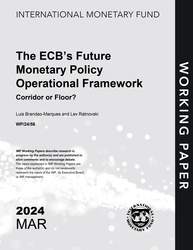
The ECB’s Future Monetary Policy Operational Framework: Corridor or Floor?
The ECB’s Future Monetary Policy Operational Framework: Corridor or Floor?
READ MORE...
Volume/Issue:
Volume 2024
Issue 056
Publication date: March 2024
ISBN: 9798400266973
$20.00
Add to Cart by clicking price of the language and format you'd like to purchase
Available Languages and Formats
| English |
Prices in red indicate formats that are not yet available but are forthcoming.
Topics covered in this book
This title contains information about the following subjects.
Click on a subject if you would like to see other titles with the same subjects.
Banks and Banking , Finance , Economics- Macroeconomics , Money and Monetary Policy , Economics / General , Central bank operations , Monetary policy , The ECB , ECB balance sheet , ECB's monetary policy objective , supply of reserve , liquidity shortage , ECB's supply , Money markets , Liquidity , Interbank markets , Central bank policy rate , Standing facilities , Global
Also of interest
Summary
This paper reviews the trade-offs involved in the choice of the ECB’s monetary policy operational framework. As long as the ECB’s supply of reserves remains well in excess of the banks’ demand, the ECB will likely continue to employ a floor system for implementing the target interest rate in money markets. Once the supply of reserves declines and approaches the steep part of the reserves demand function, the ECB will face a choice between a corridor system and some variant of a floor system. There are distinct pros and cons associated with each option. A corridor would be consistent with a smaller ECB balance sheet size, encourage banks to manage their liquidity buffers more tightly, and facilitate greater activity in the interbank market. But it would require relatively more frequent market operations to ensure the money markets rate stays close to the policy rate and could leave the banking system vulnerable to intermittent liquidity shortages that may have financial stability implications and impair monetary transmission. The floor, on the other hand, would allow for more precise control of the overnight rate and a lower risk of liquidity shortages, but it would entail a somewhat larger ECB balance sheet, weaken the incentives for banks to manage their liquidity buffers, and discourage interbank market activity. The analysis of tradeoffs suggests that, on balance, in steady state, a hybrid system that combines the features of the “parsimonious floor” (with a minimal volume of reserves) with a lending facility or frequent short-term full-allotment lending operations priced at or very close to the deposit rate, making it a “zero (or near-zero) corridor”, would be most conducive for achieving the ECB’s monetary policy objective.
Copyright © 2010 - 2026
Powered by:
AIDC



